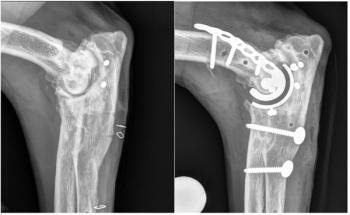
Before the end: Prepare highly attached clients to face their pets death
Planning for the inevitable can alleviate the complications of uncertainty and grief, allow clients to better assess quality of life, grieve in a way that honors the human-animal bond and provide you with the privilege to guide clients through what can be one of the most difficult decisions of their lives.
The importance of animals in the lives of humans has never been so pervasive or celebrated-spend two minutes on the Internet for countless examples. It seems this emotional public perception of animals as connected to humans, seen also in the aversion to animal deaths and killing, will inevitably become more emotional and more contentious.
In many ways, animals are playing a larger role in peoples' lives. People are more isolated. The growth in one-person households (people living alone) is responsible for most of the increase in nonfamily households over time-and the corresponding decrease in family households.1 But people still need companionship and emotional support, and they are finding it in their pets.
This personal and emotional attachment-even a feeling of being more bonded to their pets than they are to their human family-can make end-of-life decisions for these beloved pets overwhelming. In order to guide pet owners through difficult decisions, veterinarians need to be able to navigate the relationships people have with their pets and understand the current expectations and needs that pet owners have regarding humane euthanasia and end-of-life decisions.
I recently attended a session on euthanasia and end-of-life care by Elizabeth Colleran, DVM, DABVP (feline) at the CVC in San Diego and came away with the following thoughts on this arguably most difficult aspect of practice.
“Doctor, what would you do?”
Pet owners give us remarkable trust and authority, and during loss, look to us to provide strength, guidance and leadership. Given these expectations, compassionate communication should be considered both a core clinical skill and a standard of care for veterinarians, says Colleran.
But when a client asks a veterinarian for advice, what do we do? Veterinarians usually choose from three basic options when guiding clients on end-of-life decisions:
• We deflect: “It's your decision. I can't decide this for you.”
• We give options: “You can try steroids …” “I can send you to hospice care …” “You can elect amputation …” “Humane euthanasia is not a bad option.”
• We tell them what to do: “Your pet is suffering. You should euthanize.”
All of these can be the right way to handle the question depending upon the circumstances. For the client's sake, and ultimately for our own, Colleran says we must not try to solve the owner's problems by making decisions for them, rationalizing their choices or rescuing them. What becomes essential to assisting clients is our ability to educate, support, guide and facilitate during this often-difficult time.
The emotional toll
On the one hand, euthanasia is a tough subject that we face almost every day and don't talk about enough. Clients are stressed and emotional and looking to you for guidance. In one study, more than one-third of pet owners said that their major source of emotional support was their veterinarian. Mental and emotional stressors associated with euthanasia take their toll on veterinarians as well. We have a saying at our clinic: no one cries alone. I almost always cry at a euthanasia, even when I don't know the clients very well. Euthanasia is hard.
First, recognize the moral stressors involved in euthanasia that can affect you
• Convenience euthanasia. Euthanasia for reasons we can't accommodate in our minds (e.g. “My cat doesn't match my drapes”).
• Severed relationships. The client has ended the mental and emotional relationship with the pet before they have arrived, leaving nothing on which to base decisions.
• Financial constraints. The ability to afford-or a lack of desire to pay for-the care a pet needs causes a client to choose euthanasia.
• Client guilt. Veterinarians often deal with client guilt associated with euthanizing too soon or causing suffering by waiting too long.
• Technology zeal. Just because we can continue to treat and diagnose doesn't mean we should, even if the client desires it.
• Inability to let go. Client won't stop or won't quit seeking treatment even when the pet's condition cannot be cured or managed pain-free.
Second, realize you have little to no control over these moral stressors, and take care of yourself mentally and emotionally.
• Take a time out.
• Talk to someone who understands.
• Learn mindfulness-based stress reduction techniques (i.e. breathing, meditation).
Uncertainty and grief
The strongest desire of highly attached pet owners facing the loss of a beloved pet is to do what is best for the animal. It is an elusive goal and one that requires the owner's interpretation of the animal's state. There is no easy answer, particularly because we advise our clients based on proxy. As the pet's proxy, the owner makes the decision for euthanasia based on uncertain anticipated events rather than what is known. Uncertainty makes the decision more difficult.
Also, highly attached owners who recognize that their pets have a life-limiting medical condition that cannot be cured or managed pain-free experience strong emotions called anticipatory grief, says Colleran. Anticipatory grief is the psyche's way of preparing for impending loss and is a normal reaction, but unfortunately it can blur judgment. This is often the beginning of a period of powerful emotions, and end-of-life planning should be done before these emotions take over, advises Colleran.
Quality of life vs. prolonging life
In euthanasia, it is best to let clients make decisions, says Colleran, but in order to do this, they need to be able to accurately assess their pets' quality of life before their judgment is impaired by emotion. According to Colleran, one core belief that must be developed in clients is that preserving quality of life takes precedence over measures to prolong life. Medical and surgical therapy that was previously unattainable can now prolong suffering, making it more important than ever to educate clients on the importance of quality of life over quantity.
Colleran says the best practice is to teach people early on how to recognize quality of life with assessment tools and diaries, even as early as puppy and kitten wellness visits. At the end, we want to be able to remind people with that point of reference what quality of life looks like in their pet, instead of trying to teach them about quality of life during an often-emotional moment. Quality of life assessment tools give clients power and confidence by allowing them ability to quantify something that is typically unquantifiable. I use
Helping a child say goodbye
Seeing a pet euthanized can be traumatic for young children, even if it is peaceful. If there are young children involved, help them say goodbye, and advise the parents to excuse them for the euthanasia, Colleran says. Be mindful in the way you communicate with kids: children younger than 9 or 10 will not understand that “I am putting your pet to sleep” means death. Colleran advises veterinarians to use concrete language: “I am helping your pet to die because she is suffering and we can't control her pain any longer. This is really hard and sad thing for us, but it is a good and brave thing to do for your pet. It is OK to be sad.”
Plan for the inevitable
Planning ahead also involves making sure that clients have access to medical records and a plan in place if something goes wrong or timing is wrong, says Colleran. In addition, it can help the client to decide ahead of time if children or other pets should be present, where the euthanasia will occur (at home, at the clinic, outside), body care and more.
We may be the only person in that client's life that recognizes the human-animal bond between the client and the pet. We can plan to honor that connection and provide emotional support for the client after the pet has passed on. Celebration of life ceremonies, telling funny stories about the pet, a funeral, special mementos, art work, music or candles can all help a highly attached client cope with the loss, so don't be afraid to ask how the client will be honoring the passing of his or her pet. If your client doesn't have any ideas, don't be afraid to give some suggestions. In doing so, you may be giving that client permission to grieve in a healthy way that he or she may not have considered. Ritual can bring comfort and closure.
By preparing the client for end-of-life decisions, helping the client plan and providing emotional support to your client, you have the opportunity to provide exceptional service and protect the human-animal bond. The manner in which a veterinarian provides care for a client whose pet has died has the potential to alleviate or aggravate grief and influence client and veterinarian satisfaction-even create or destroy long-lasting relationships, says Colleran.
Presenting options gives families control over the process of inevitable loss by helping them define for themselves what constitutes the best way to care for their animal. I believe a sense of control-even if limited-correlates with healthy grieving and emotional healing. Just as humane euthanasia is a privilege to end suffering, guiding clients through the process can be a privilege as well.
Reference
1. Vespa J, Lewis JM, Kreider RM. America's family and living arrangements: 2012. United States Census Bureau. Available at
Newsletter
From exam room tips to practice management insights, get trusted veterinary news delivered straight to your inbox—subscribe to dvm360.






